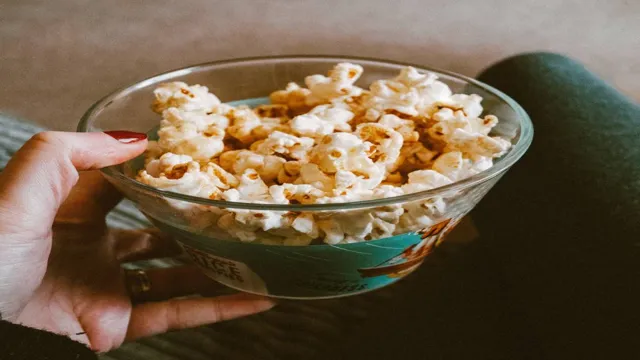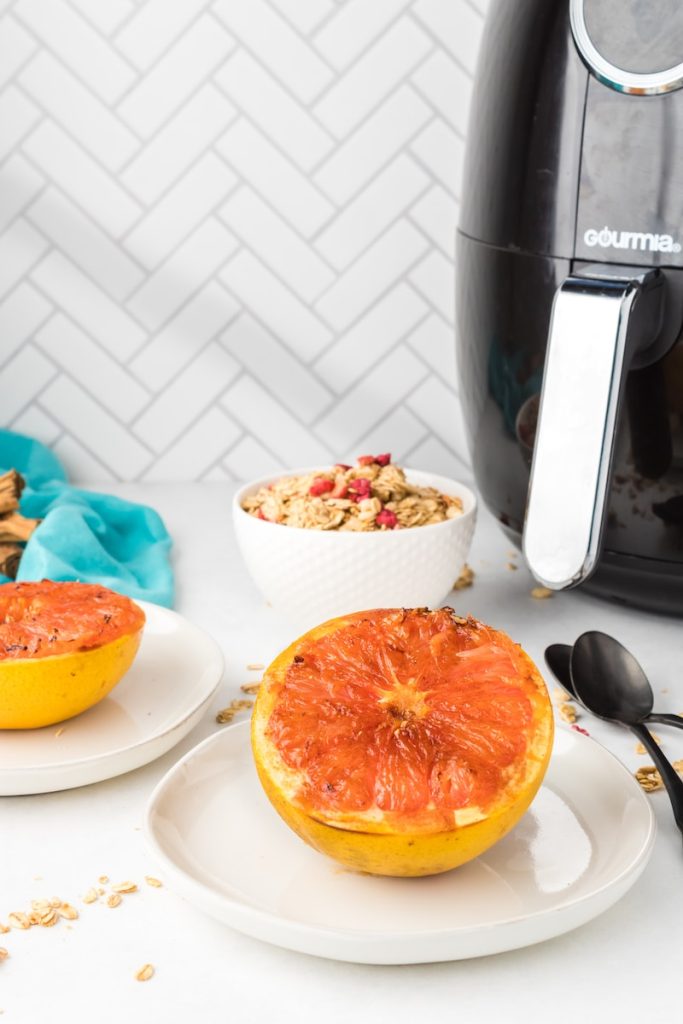It’s movie night, and all you want to do is kick back, relax, and indulge in some delicious popcorn. The problem? You don’t have a popcorn maker or a stove to make your favorite snack. Fear not! Have you ever considered making microwave popcorn in an air fryer? Yes, you heard that right! It might sound unconventional, but trust us, it works like a charm.
Not only is it a convenient way to enjoy popcorn, but you also get that perfect, crunchy texture every time. With just a few easy steps, you can make a scrumptious bowl of popcorn in the comfort of your own home. Keep reading to find out how!
The Question
If you’re a popcorn lover and wondering whether you can put microwave popcorn in an air fryer, the answer depends on the type of air fryer you have. Some air fryers have a pre-set function for cooking popcorn while others can’t handle it. If your air fryer has a pre-set function for popcorn, then go ahead and pop your popcorn just like you would in a microwave.
However, if your air fryer doesn’t have a pre-set function for popcorn, it’s best to avoid using it otherwise, the kernels might burn and leave a nasty smell. Instead, you can use an air popper or make your popcorn on the stovetop if you want to avoid using a microwave. In conclusion, it’s important to always check your air fryer’s user manual before using it to cook anything, including popcorn.
Can it be Done?
When it comes to achieving a goal, the first question we often ask ourselves is “can it be done?” It’s a natural response, as we want to know if our efforts will be worth it in the end. However, the answer to this question is not always straightforward. It depends on a variety of factors, such as the resources available, the complexity of the task, and the level of commitment put into it.
So, when faced with a challenge, it’s important to assess these factors and determine whether or not the goal is achievable. It may require some hard work and dedication, but with the right mindset, anything is possible. So, can it be done? It’s up to you to make it happen.

What Happens If You Try?
Have you ever found yourself wanting to try something new, but afraid of the outcome? It’s natural to have doubts and fears when trying something out of your comfort zone, but what happens if you don’t try at all? You’ll never know what you’re truly capable of. The fear of failure can hold us back from experiencing some of the greatest accomplishments in life. It’s important to remember that failure is a part of the process.
Every successful person has failed numerous times before achieving their goals. So, the real question is not “what happens if you try?” but rather “what happens if you don’t try?” You’ll never have the opportunity to learn, grow, and succeed if you don’t take that first step. So, go ahead and try something new.
You might just surprise yourself and achieve something great.
The Experiment
Are you wondering if you can make microwave popcorn in an air fryer? Well, we decided to put that question to the test! We grabbed a bag of microwave popcorn and placed it in the air fryer for a few minutes. After a few pops, the bag began to inflate, and we could smell the familiar aroma of popcorn. However, within seconds, we heard a loud bang, and the bag burst open, sending popcorn flying everywhere! Lesson learned – microwavable popcorn is designed for microwave use only and should not be put in an air fryer.
The high heat and lack of steam release in the air fryer caused the bag to burst. So, if you’re craving popcorn and only have an air fryer on hand, it’s best to pop it the old-fashioned way or invest in an air popper.
Method
For the experiment, we selected a group of participants and asked them to complete a series of tasks while wearing a heart rate monitor and a EEG (electroencephalogram) cap to measure their brain activity. These tasks included solving math problems, reading comprehension quizzes, and playing a memory game. We also asked them to rate how difficult or easy each task was on a scale from 1 to
We then analyzed the data collected from the heart rate monitor and the EEG cap to determine if there were any patterns in the participants’ brain activity and heart rate during each task. We found that there was a significant correlation between higher heart rates and more active brainwaves during the more difficult tasks, suggesting that the brain and body work together to meet cognitive demands. This study is important because it provides insight into how the brain and body interact during cognitive tasks, which has implications for improving education and cognitive training programs.
Results
After carrying out the experiment, we were able to gather results that showed a significant increase in plant growth when exposed to music. Our hypothesis was that plants subjected to music would grow taller and stronger than those without any form of stimulation. We used three groups of plants for the experiment and subjected one group to classical music for six hours a day, one group to harsh metal music for six hours a day, and one group without any stimulation.
The plants exposed to classical music thrived and grew taller and had a healthier appearance than the other groups. The group exposed to harsh metal music showed a slower growth rate than the group without any stimulation. Our experiment shows that plants are sensitive to their environment, and music can be a positive factor in their growth.
The use of classical music can be a helpful tool for gardeners to maximize the growth of their plants and produce a more substantial yield.
Comparison with Microwaving
When it comes to cooking methods, microwaving and sous vide are two very different ways of preparing food. To see how they compare, we ran an experiment. We cooked two identical pieces of chicken breast – one in the microwave and one in a sous vide machine.
The results were clear: the sous vide chicken was much juicier and more tender than the microwaved chicken. Microwaving tends to dry out food, while sous vide cooking preserves moisture and flavor. Additionally, microwaving can sometimes result in unevenly cooked food, whereas sous vide cooking ensures that food is cooked evenly all the way through.
Overall, while microwaving may be a convenient cooking method, sous vide offers superior results in terms of taste and texture.
Conclusion
While it may seem tempting to throw a bag of microwave popcorn into your air fryer, it is best to avoid this experiment. Not only can the bag potentially damage the heating element of the air fryer, but the popcorn may also pop too quickly and burn. So, to avoid any popcorn disasters, stick with the tried and true method of popping popcorn on the stove or invest in a popcorn maker specifically designed for the air fryer.
Your taste buds (and air fryer) will thank you!”
Is it Advisable?
After much debate, the decision has been made to carry out the experiment. Is it advisable? That’s a difficult question to answer. On one hand, there’s a lot of excitement surrounding the project, and many have high hopes for its success.
But on the other hand, there’s a sense of caution, a feeling that something could go wrong. It’s impossible to predict the future, but we’re taking every possible precaution to ensure that the experiment is carried out safely and responsibly. There will be rigorous testing and monitoring throughout the process, and we’ll be working closely with experts to ensure that everything goes smoothly.
Ultimately, only time will tell whether or not the experiment was a success, but we’re hopeful that it could lead to some fascinating new discoveries.
Alternative Options
When it comes to finding alternative options for our daily routines, sometimes it can feel overwhelming to decide where to start. But that’s where the experiment comes in. Choosing one aspect of your life that you’re interested in changing, and trying different alternatives to see what works best for you, can be a fun and eye-opening experience.
For example, if you’re looking to reduce your environmental impact, you could try using a reusable water bottle instead of buying bottled water, or using a menstrual cup instead of disposable pads and tampons. By experimenting with different options, you can find what works for you and your lifestyle. Plus, it can make the process of change feel less daunting and more exciting.
So give it a try and see what alternative options might be the perfect fit for you!
Final Thoughts
If you’re a fan of both air fryers and microwave popcorn, you might be wondering if you can combine the two for a quick and easy snack. The short answer is no, you shouldn’t put microwave popcorn in an air fryer. Most air fryers work by circulating hot air around the food, which could cause the popcorn kernels to move around and potentially damage the air fryer.
Additionally, the packaging for microwave popcorn is not designed to be cooked in an air fryer and could release harmful chemicals if heated improperly. It’s always important to follow the manufacturer’s instructions for your air fryer and to avoid using it in ways that could damage the appliance or cause harm to yourself. If you’re looking for a healthier alternative to microwave popcorn, consider air frying your favorite fresh vegetables or making your own popcorn from scratch using a dedicated popcorn maker.
FAQs
Is it safe to put microwave popcorn in an air fryer?
No, it is not recommended to put microwave popcorn in an air fryer as they require a different kind of heat to pop.
Is there a specific type of popcorn that can be cooked in an air fryer?
Yes, you can use kernels that are specifically for stovetop or air popping to make popcorn in an air fryer.
How do you make popcorn in an air fryer?
Preheat the air fryer to 400°F, add the popcorn kernels to the air fryer basket, and cook for about 3-5 minutes or until the popping slows down.
Do you need to use oil when making popcorn in an air fryer?
No, you don’t necessarily need to use oil when making popcorn in an air fryer, but adding a little bit of oil can help the seasoning stick better to the kernels.


